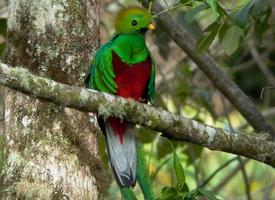
Poids et mesures
| Longueur | 36 cm |
|---|---|
| Poids | 210 g |
| Longueur de la queue | 64 cm |
Description de l'animal
The Resplendent Quetzal (Pharomachrus mocinno) is a strikingly beautiful bird that inhabits the montane cloud forests of Central America, from southern Mexico to western Panama. It is one of the most iconic and revered birds in its range, deeply embedded in the mythology and culture of the ancient civilizations that once flourished there, most notably the Maya and the Aztecs. The bird's name, "quetzal," originally comes from the Nahuatl word quetzalli, which was used to describe the bird's brilliant plumage or could mean "precious" or "beautiful" in the Aztec language.Physically, the Resplendent Quetzal is known for its vibrant and iridescent plumage. The male, in particular, boasts an extraordinary display of colors with a vivid green back, wings, and head, which can appear turquoise or even blue depending on the light. Its breast and belly are a deep crimson red, and it has a conspicuous helmet-like crest on its head. Perhaps the most remarkable feature of the male quetzal is its tail feathers, which can grow up to a meter in length during the breeding season, flowing behind them in a spectacular train that far exceeds the rest of their body. The females, while still beautiful, are less ostentatious, with shorter tail feathers and a more subdued color palette that includes shades of green, gray, and red.
The Resplendent Quetzal is a solitary or sometimes paired bird when it comes to behavior, known for its elusive nature. It thrives in the dense, misty forests of high altitudes, where it prefers to stay well hidden among the foliage. Its diet primarily consists of fruit, particularly wild avocados and other types of laurel fruits, which it swallows whole before regurgitating the pits. The bird is also known to consume insects, small reptiles, and frogs, especially when feeding its young.
Breeding season brings out the most visible changes in the quetzal's behavior. The male uses its splendid tail feathers to attract a female, engaging in elaborate aerial displays. Once a pair is formed, they work together to excavate a nest in a rotten tree or a stump, where the female lays two blue eggs. Both parents share incubation duties over a period of about 18 days until the eggs hatch. After hatching, the chicks are fed by both parents and fledge in approximately three weeks, although they remain dependent on their parents for feeding for some time after.
Despite its revered status, the Resplendent Quetzal faces threats from habitat destruction due to deforestation, agriculture, and human settlement expansion. It is also vulnerable to climate change, which impacts the cloud forests it calls home. Conservation efforts are in place in several regions to protect this magnificent bird and its habitat, including the establishment of protected areas and reforestation projects. The Resplendent Quetzal is not only a symbol of the inherent beauty of our planet's biodiversity but also a reminder of the importance of conservation and the delicate balance of ecosystems.
Nouvelles photos d'animaux
Top 10 des animaux
- Dolphin gull (Leucophaeus scoresbii)
- Diana monkey (Cercopithecus diana)
- Moustached guenon (Cercopithecus cephus)
- Galápagos tortoise (Geochelone nigra complex)
- Russian tortoise (Testudo horsfieldii)
- Japanese macaque (Macaca fuscata)
- Stone loach (Barbatula barbatula)
- Greek tortoise (Testudo graeca)
- Common flying dragon (Draco volans)
- Colossal squid (Mesonychoteuthis hamiltoni)